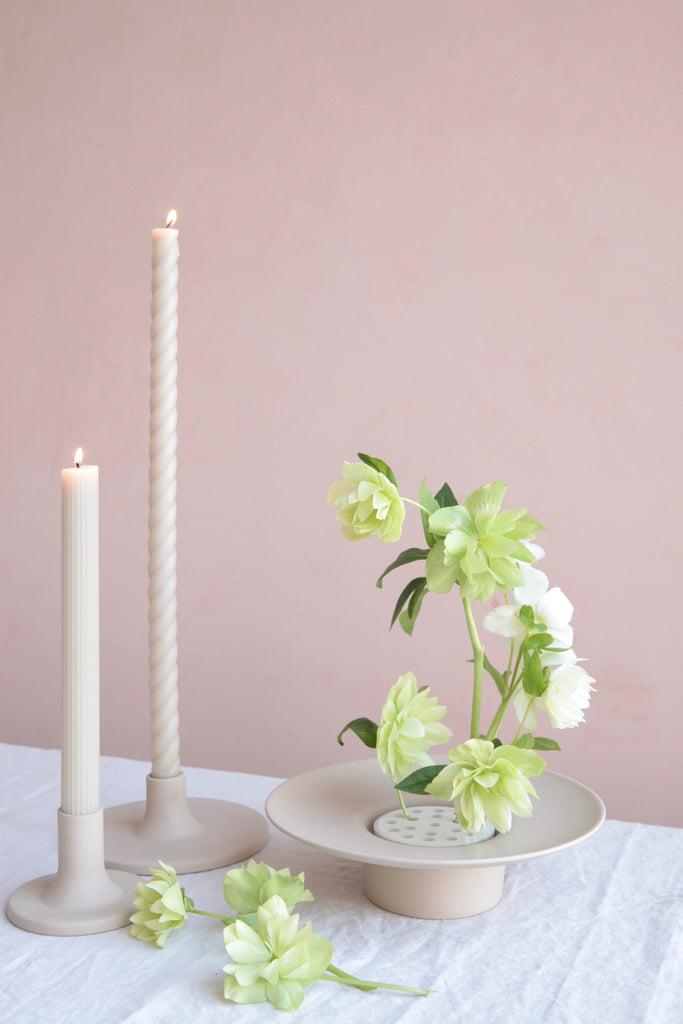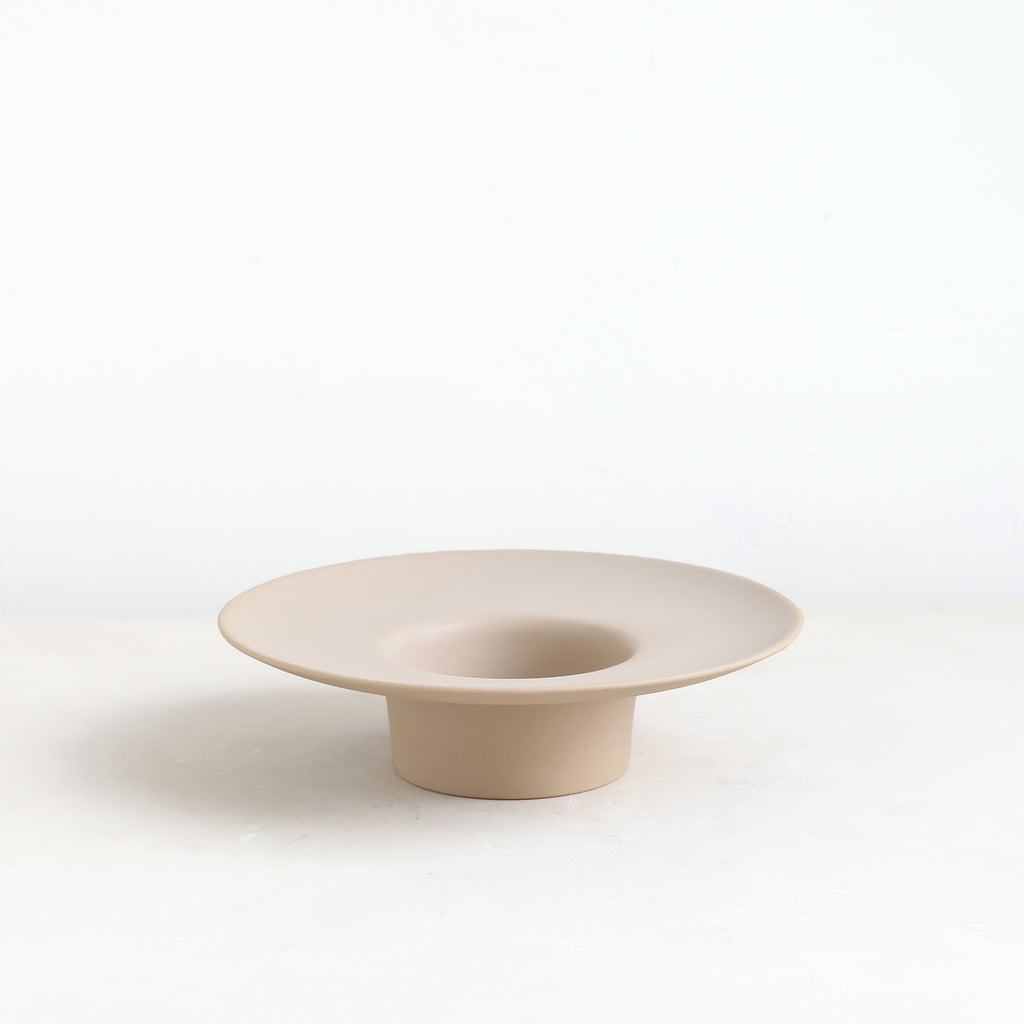Over the past 15 years as a floral designer, I’ve worked with many types of vases and the Ikebana style remains among my favorites. The Japanese art of flower arranging, Ikebana, seeks to imitate nature, by having an eye for space, color, and lines. This nature-focused aesthetic is what sets Ikebana vases apart from other vessels. The designs are minimalistic, neutral-toned, and shallow enough to allow the water to show. For those who enjoy a simple, clean, look to for their interior, Ikebana arrangements are a wonderful addition to the home. To help guide your arrangement, start below by exploring the different types of vases.
What is Ikebana?

Ikebana is a distinct style of flower arranging rooted in spirituality. Introduced to Japan in the 6th century, the method was used by Chinese Buddhist missionaries as temple offerings to Buddha. Over time it became a coveted floral technique in Japan and then around the world.
The word Ikebana originates from the Japanese words ikeru (to arrange/to plant, or living) and hana (flower). While other floral arranging techniques highlight the art of improvisation, the core of Ikebana is intentionality. The essential principles of ikebana arrangements make use of lines, movement, space, color, and balance to create meaning.
The spiritual origins of Ikebana are infused in the creative process. Ikebana is seen as a form of meditation and is meant to be done in silence, for a peaceful and focused mind. Silence is only one of seven principles incorporated in the practice. The other principles include shape and line, form, humanity, aesthetics, structure, and minimalism.
Minimalism is central to Ikebana and is what distinguishes it from fuller Western-style arrangements. This simplicity is consistent with the Japanese aesthetic of design. While Ikebana vases vary in size, shape, and length the arrangement inside must include a scaled triangle. The triangle represents the three elements of heaven (shin), humanity (soe) and earth (hikae), and is usually formed with branches or twigs.
Although Ikebana is deliberate in its method, it still gives flower arrangers the opportunity to incorporate themselves into their creations. Those who follow the principles of Ikebana do not plan their arrangement and instead let their emotions guide them during the process. With this in mind, the result is the artist becomes reflected in their floral design.
Vase Styles

Just like with Ikebana arrangements, Ikebana floral vases must adhere to the principles of the technique. The design of the vase should be balanced, aesthetic, and in most cases, allow for the water to be visible. Ikebana arrangements are meant to mimic how plants grow in nature, so vases are created with this in mind.
There are several styles of vases to choose from for your arrangement, including flower frog vases, classic upright vases, oblong boat-shaped vases, bamboo vases, and cylindrical vases, to name a few. Each vase is characterized by its own style and symbolism. Below discover the different varieties of Ikebana vases to find the one that reflects you.
Moro-hanaire: The Classic Upright VaseThe Moro-hanaire is perhaps the most recognizable ikebana vase. Characterized by its tall and slender form, it is designed to hold long and elegant floral compositions. Its elongated neck provides support for the arrangement's stems and allows for a graceful display of flowers. This vase type is ideal for the traditional upright ikebana style called "Rikka," which symbolizes nature's majestic beauty.
Nageire-hanaire: The Tossed-In VaseIn contrast to the Moro-hanaire, the Nageire-hanaire is shorter and wider, with a mouth that flares outward. It is designed for the "Nageire" style of ikebana, where flowers are arranged by tossing them casually into the vase. This style encourages a more spontaneous and naturalistic approach, and the vase's shape accommodates the free-form nature of Nageire arrangements
Suiban: The Water Basin VaseSuiban, which translates to "water basin," is a shallow, flat container that plays a unique role in ikebana. Instead of holding water directly, it is typically used in combination with a kenzan (a metal flower frog) to secure the stems. For this reason, they are also sometimes referred to as flower frog vases. Suiban vases are often used for the "Moribana" style of ikebana, which emphasizes the harmony between the natural elements, such as water, land, and plants.
Shoka-hanaire: The Formal Linear VaseShoka-hanaire vases are tailored for the Shoka style of ikebana, which focuses on simplicity and balance. These vases are usually cylindrical and come in various heights to accommodate different ikebana arrangements. The Shoka style typically features three main stems representing heaven, earth, and humanity, and the vase's form complements this arrangement with its clean lines and understated elegance.
Jushi: The Bamboo VaseBamboo is a beloved material in Japanese culture, and the Jushi vase, made from bamboo, embodies the essence of ikebana's connection with nature. These vases are often handcrafted, showcasing the versatility of bamboo in both form and function. The Jushi vase is suitable for a range of ikebana styles, including Nageire and Moribana, and adds a rustic charm to floral compositions.
Uzukuri: The Repaired VaseUzukuri vases are unique in that they have been intentionally cracked and repaired using a traditional Japanese technique called "kintsugi." This art form values the beauty of imperfections and celebrates the journey of restoration. Uzukuri vases remind us that even in brokenness, there is an opportunity for beauty and resilience, making them a meaningful choice for ikebana enthusiasts.
Moribana-hanaire: The Piled-Up VaseMoribana-hanaire is a traditional ikebana vase specifically designed for the Moribana style of ikebana. This style involves arranging flowers in a shallow vase with a kenzan, allowing for greater control over the composition's height and structure. Moribana-hanaire vases are typically low and wide, facilitating the creation of dynamic and layered arrangements.
If there is not a built-in flower frog to the vase, a pin frog is placed at the bottom to create the mechanics for your ikebana arrangement. The flowers are displayed in a way that mimics how they naturally grow from the ground.
Ikebana Tools to Enhance Your Arrangement
Pin Frog
One of the most essential tools in ikebana is a pin frog, also commonly known as a kenzan. Pin frogs are designed in various shapes to fit at the bottom of your ikebana vase. The most used shape is a round pin frog. Long pins are placed close together to hold any design snugly in place. The base is heavy, keeping it in place at the bottom of your vase.
Pin frogs are commonly used in ikebana vases to hold flower stems at desired angles. However, these nifty tools are more than a sturdy base. Their unique design allows flowers to absorb more water - which in turn allows for your flower arrangements to last longer.
Flower Frog Toppers
Flower frog toppers are a utilitarian design mechanic and often made of metal. The flower frog topper is used to space stems out and hold them in place. They can be used on cylinder vases, in ikebana vases or with any home vase, mason jar or vessel with the appropriately sized opening.
Arranging Tip: Before you begin arranging make sure to wash your vase with dish soap and rinse it clean.
Find the Right Ikebana Vase For Your Home
The art of ikebana is a creative way to pay tribute to the beauty of nature. Whether you desire the classic elegance of the Moro-hanaire, or the whimsical free-flowing Nageire-hanaire, there is an ikebana vase to fit your home. Each ikebana vase has its own unique function and personality and ikebanists are invited to explore what vessel suits their personal aesthetic.

